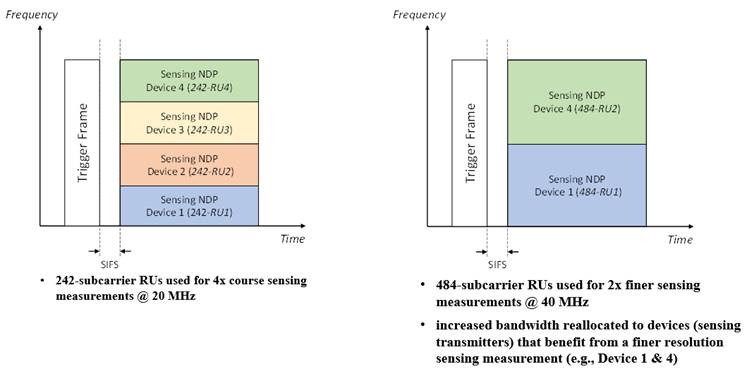Hi Claudio,
Thanks again for the comments, and further discussion on this topic.
To start, I want to highlight the scenario on Slide 8 of my presentation, where we have an environment with an AP and multiple 11bf compatible STAs. One of the first tasks any sensing
application will need to perform, is selecting which STAs should be utilized for participating in the measurement phase. Such a task may involve the application scanning for targets, which would require performing one or more measurements with the available
STAs. This can potentially be performed at a lower bandwidth (e.g., a coarse measurement). Once the application knows which channels or STAs which can see the target, then full bandwidth measurements can be setup and performed using a subset of STAs (e.g.,
fine measurement).
My motivation of this proposal is to utilize the functionality of UL-OFDMA as a tool to help perform this type of task in an efficient manner, since an application would likely perform
it at regular intervals. My thought is UL-OFDMA offers a nice way to coordinate a number of measurements between an AP and multiple STAs to occur in parallel, reducing the OTA time footprint, specifically for case where the AP is the Sensing Initiator + Sensing
Receiver.
I also see that this scenario is applicable to help improve the efficiency of the non-AP STA Sensing application, by utilizing the AP proxy concept. If the AP is able to obtain a measurement
from multiple STAs in a single UL-OFDMA transmission, it will add flexibility and save performing multiple sequential triggers + NDP transmissions.
Thanks and regards,
-Chris
From: Claudio Da Silva [mailto:claudiodasilva@xxxxxx]
Sent: November 2, 2021 6:32 PM
To: Chris Beg <chris.beg@xxxxxxxxxxxxxxxxxxxx>; STDS-802-11-TGBF@xxxxxxxxxxxxxxxxx
Subject: [External]RE: Offline OFDMA Discussion
Hi Chris,
In addition to the “partial bandwidth NDP” issue, I’m afraid the motivation of the proposal is still not clear to me.
Specifically, I was hoping you could help me understand the need to assign different users to different channels/RUs in sensing. For instance, looking at the two figures below (slide 7 of your contribution), it is not
clear why we couldn’t simply transmit a 20 MHz NDP (left figure) or a 40 MHz NDP (right) instead of transmitting an 80 MHz NDP. If we used a 20 MHz NDP, for example, the 4 users on the first case would be able to estimate a 20 MHz channel. Isn’t that what
we need? Using an 80 MHz NDP as shown in the figure results in the same (20 MHz estimates), but it uses more resources.
Different from data transmission, I don’t see at the moment the need in sensing to multiplex users in the frequency domain through OFDMA.
Thanks,
Claudio

From: Chris Beg
chris.beg@xxxxxxxxxxxxxxxxxxxx
Sent: Tuesday, November 2, 2021 2:32 PM
To: STDS-802-11-TGBF@xxxxxxxxxxxxxxxxx
Subject: [STDS-802-11-TGBF] Offline OFDMA Discussion
Hi everybody,
As I mentioned during the discussion of 21-1602r0 (https://mentor.ieee.org/802.11/dcn/21/11-21-1602-00-00bf-ofdma-measurement-discussion.pptx),
I wanted to open up an opportunity for any offline comments or discussion regarding the usage of OFDMA for Sensing before I run the SP.
One good point was raised on the need to define a partial bandwidth NDP, which would be appropriate. I’m interested to hear any thoughts or potential concerns on doing that within 11bf.
For the HE-PHY case, equation 27-59 in the 11ax spec describes the HE-LTF of an HE TB PPDU. From what I can tell, it constrains the definition to only subcarriers within the STAs allocated RU (e.g., subcarriers in the
set Kr).
Therefore, could this be achieved within the scope of 11bf by extending the 11az TB Ranging NDP definition to allow flexibility in TXVECTOR.RU_ALLOCATION, and defining appropriate additions to the 11az MLME section describing
the measurement exchange?
Thanks and regards,
-Chris
Confidentiality Warning: This message and any attachments are intended only for the use of the intended recipient(s), are confidential, and may be privileged. If you are not the intended recipient, you are hereby notified that any review, retransmission, conversion
to hard copy, copying, circulation or other use of this message and any attachments is strictly prohibited. If you are not the intended recipient, please notify the sender immediately by return e-mail, and delete this message and any attachments from your
system.
To unsubscribe from the STDS-802-11-TGBF list, click the following link:
https://listserv.ieee.org/cgi-bin/wa?SUBED1=STDS-802-11-TGBF&A=1
To unsubscribe from the STDS-802-11-TGBF list, click the following link: https://listserv.ieee.org/cgi-bin/wa?SUBED1=STDS-802-11-TGBF&A=1